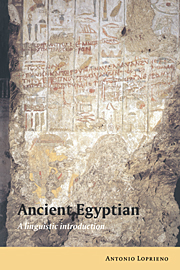Book contents
- Frontmatter
- Contents
- Preface
- Major Chronological Divisions of Egyptian History
- 1 The language of Ancient Egypt
- 2 Egyptian graphemics
- 3 Egyptian phonology
- 4 Elements of historical morphology
- 5 Nominal syntax
- 6 Adverbial and pseudoverbal syntax
- 7 Verbal syntax
- Epilogue
- Notes
- References
- Index of passages
- Index of morphemes
- Index of lexemes
- Index of topics
3 - Egyptian phonology
Published online by Cambridge University Press: 08 December 2009
- Frontmatter
- Contents
- Preface
- Major Chronological Divisions of Egyptian History
- 1 The language of Ancient Egypt
- 2 Egyptian graphemics
- 3 Egyptian phonology
- 4 Elements of historical morphology
- 5 Nominal syntax
- 6 Adverbial and pseudoverbal syntax
- 7 Verbal syntax
- Epilogue
- Notes
- References
- Index of passages
- Index of morphemes
- Index of lexemes
- Index of topics
Summary
Introduction
At the present state of our knowledge, a discussion of Egyptian phonology must be addressed primarily as an issue of diachronic, rather than synchronic linguistics. While it is possible to recognize regular patterns of sound change in the history of the Egyptian language as a whole, including in many cases Afroasiatic antecedents, the synchronic systems of phonological oppositions at any given time in the four millennia of the productive history of this language often defy a clear analysis. Furthermore, our models of historical phonology tend to hide many uncertainties behind the regularity of the reconstructed paradigm, conveying the misleading impression that for each of the different phases of the language (Old, Middle, and Late Egyptian, Demotic, and Coptic) we are able to establish a discrete phonological system.
The actual phonetic realities underlying the abstract reconstructions are even more elusive: the traditional pronunciation and transliteration of many Egyptian phonemes rest upon hardly anything more than scholarly conventions, and even for the relatively well-known Coptic, in which Egyptian sounds are rendered in a Greek-based alphabet, it is difficult to assess reliable phonetic values for some of the Greek signs and the Demotic graphemes that were added to the Greek alphabetic set.
In fact, the main reason for the difficulties in reconstructing the phonology of Ancient Egyptian lies in the nature of the writing system: Hieroglyphs, Hieratic and Demotic represent the mere consonantal skeleton of a word (and sometimes only a portion thereof), followed by indicators of lexical classes, the so-called “determinatives.” Semivocalic phonemes are rarely indicated, vowels practically never.
- Type
- Chapter
- Information
- Ancient EgyptianA Linguistic Introduction, pp. 28 - 50Publisher: Cambridge University PressPrint publication year: 1995



